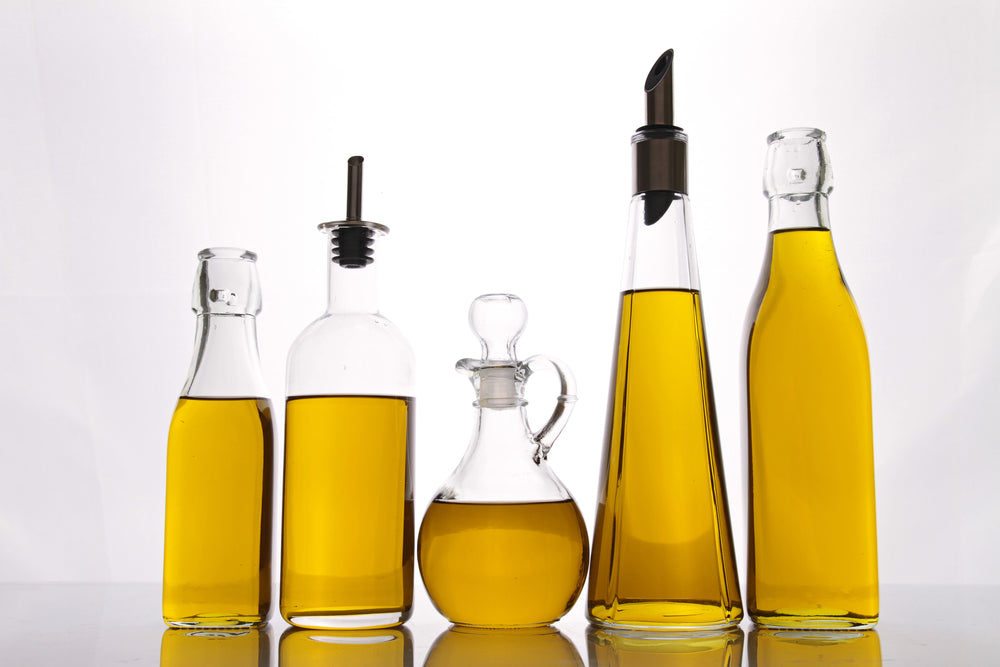Wondering what the best and healthiest cooking oil are? With so many different options, how do you know which is the healthiest oil to cook with? Are you getting enough omega-3 and omega-6 fatty acids? What about polyunsaturated and monounsaturated fat? Does that even matter? From the tireless google searches and advice your friends have given you, we thought it was about time we gave you some cold hard facts about the healthiest oils you should cook with.
Here are a few key things to keep in mind, when choosing a healthy cooking oil.
- Calories: All cooking oils will have around 120 calories and 13 grams of fat per tablespoon. There aren't oils you can cook with that are magically lower in calories than others. So if you're trying to cut your caloric intake by using a different type of cooking oil, think again.
- Composition: What makes cooking oils different from one another is the nutritional makeup and composition, in terms of monounsaturated (MUFA) and polyunsaturated fats (PUFA) which has a direct affect on cooking temperatures and biological reaction.
- Smoke Point: Smoke point refers to the temperature, at which the oil starts to break down, or loses its nutritional value. Oils with high smoke points are better for cooking, searing, and frying. Oils with low smoke points are better used for finishing glazes, salad dressings, and added flavor.
- Omega Balance: Omega-3 and Omega-6 fatty acids are polyunsaturated fats (PUFAs). The typical American diet is stacked with an abundance of Omega-6 fatty acids, yet lacks significantly in Omega-3. Try to supplement with oils, that have a balanced Omega ratio, to derive the best nutritional complex for your diet. If not, then you can supplement with OMEGA 3/6/9
Olive Oil

77% MUFA, 9% PUFA, 14% saturated
The most popular and perhaps the best cookings oils is Olive Oil. Rich in polyphenols; antioxidant compounds that contain anti-inflammatory properties and the monounsaturated fat oleic acid, Olive Oil is a very healthy option for cooking.
Choose Extra-Virgin Olive Oil for dressings or low-heat applications for a more robust flavor.
Smoke point: 375–470ºF
Avocado Oil

71% MUFA, 13% PUFA, 12% saturated
Avocados are loaded with a high ratio of omega-6 to omega-3 fatty acids, which is a great way to incorporate healthy essential fatty acids into your diet. The best thing about this superfood oil is that it can be used with salads and other low-heat applications, but is also a great option for cooking.
Smoke point: 400ºF
Coconut Oil

6% MUFA, 2% PUFA, 92% saturated
Coconut oil is composed of a special type of a healthy saturated fat called a medium-chain fatty acid (MCFA). MCFAs are rapidly burned by the liver and used for energy as opposed to being stored as fat. Coconut Oil is perhaps the only oil, that also has a wide array of different health benefits and applications, as it can be used for your hair and skin. Plus, it's one of the best and healthiest oils to cook with, especially if you like a toasted coconut taste.
Smoke point: 350ºF
Grapeseed Oil

16% MUFA, 70% PUFA, 10% saturated
Grapeseed oil contains a large number of polyunsaturated fats (PUFAs) like omega-6 and omega-9 fatty acids. Despite Grape Seed Oil’s healthy molecular composition, most people already get a relatively large amount of these (PUFAs) in their diet, which means cooking with Grapeseed Oil can actually case more harm than good. Grapeseed Oil does have some positive attributes, however it does lack in nutrients such as Vitamin K, Vitamin C, Copper, and Potassium. In comparison to other cooking oils, and considering available nutrients, you’re probably better off cooking with olive or coconut oil and just eating grapes.
Fun fact: grapeseed oil is made from discarded grapes after they’re used for wine making?
Smoke point: 390ºF
Flaxseed Oil

18% MUFA, 73% PUFA, 9% saturated
Flaxseed oil is a great source of Omega-3 fatty acids. However it has very low smoke point, which makes it a great option for low-heat applications such as dressings, but not for cooking.
Smoke point: 225ºF
Ghee

4% MUFA, 29% PUFA, 61% saturated
Ghee is a clarified butter, but it’s simmered longer to bring out the nutty taste that butter hides. Ghee is traditionally made from the buffalo or cows milk, and has a very unique nutritional profile. The milk protein is removed from ghee, therefore it has no lactose or casein properties, making it a great option for those who have are dairy-intolerant or lactose sensitive. With a high smoke point, Ghee is a great cooking option.
Smoke point: 450ºF
Pumpkin Seed Oil

26% MUFA, 51% PUFA, 33% saturated
Pumpkin seed oil is derived from the hulled seeds of the pumpkin. Like other oils rich in polyunsaturated fats, pumpkin seed oil has a low smoke point, making it an ideal oil for application such as marinades, dressings and spreads. Pumpkin seeds are an excellent source for vitamin E, beta carotene, and zinc, so similar compounds will be present to varying degrees in the oil itself. If you’re looking to spice things up in your Kale salad this autumn, (not your pumpkin spice latte) pumpkin seed oil would be an excellent choice.
Smoke point: 320ºF
Walnut Oil

23% MUFA, 63% PUFA, 9% saturated
With a delicate and nutty flavor, Walnut oil is the perfect complement used as glazes, sauces, and dressings. Walnut Oil is also rich in Omega-3 fatty acids and vitamins B1, B-2, and B-3, providing added health benefits to your nutrition.
Smoke point: 160–200ºF
Hemp Seed Oil

17% MUFA, 75% PUFA, 9% saturated
Hemp seeds come from the cannabis plant, the same plant that marijuana is derived from. Despite the stigma associated with its botanical relationship to cannabis, hemp seed oil does not have any psychotropic reactions, containing only a trace amount of tetrahydrocannabinoids (THC). In fact, they’re very safe and healthy. Hemp seeds are rich in omegas and Gamma-Linolenic Acid (GLA), which helps regulate hormones and control inflammation. Hemp seed oil is a finishing oil, and should be used for dressings, glazes and other low-heat applications, as the nutritional properties will be broken down during the cooking process.
Smoke point: 330ºF
Vegetable Oil
24% MUFA, 61% PUFA, 15% saturated
Despite the name, this is one oil that you should never use. Most vegetable oil brands are largely composed of soybeans, or blends of safflower, canola, sunflower, or corn made from genetically modified crops, with high yields of pesticides. It’s almost always refined and typically found in most highly processed foods.
Smoke point: 450ºF
So What Is The Best And Healthiest Cooking Oil?
It depends! One of the most notable changes of the last decade is the staggering shift in the number of cooking oils offered to consumers. Traditionally we used butter, margarine, or vegetable oil since those were the only options we had. Now, with a litany of different options, it's tough to choose. It's important to pick a cooking oil that has a high smoke point, and that's rich in important nutritional properties, like a well-balanced ratio of Omega fatty acids. Our method is to choose a few and cook with the appropriate paired food application. You're not going to use Coconut Oil on a bacon wrapped filet, so Ghee might be a better choice. But if you're making stir-fry, you can try Coconut, Olive, or Avocado Oil. Based upon the food you're cooking, find the oil that has the right nutritional content and apply it.
Need help in getting a well-balanced amount of Omega 3 fatty acids? Try our KRILL OIL + Astaxanthin and get the essential fats you need to power your active lifestyle
Click The Image To Get Started
SWOLVERINE is an endurance athlete and active lifestyle brand. Made for the elite athlete, and the strong-willed our products were designed to fuel your athletic performance. We perform when you perform.
We believe that everyone can optimize not only their athletic performance but their human potential. The way we believe we can optimize performance is through transparency, clinically effective doses, and clinically proven ingredients with evidence-based outcomes. We provide the nutrients you need to power your active lifestyle.
Find similar articles:
Nutrition






